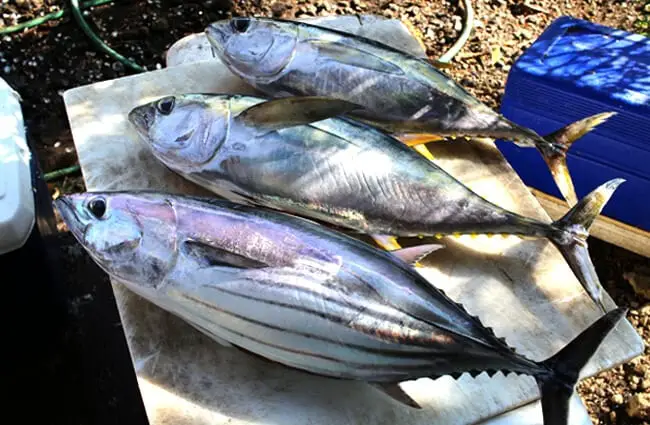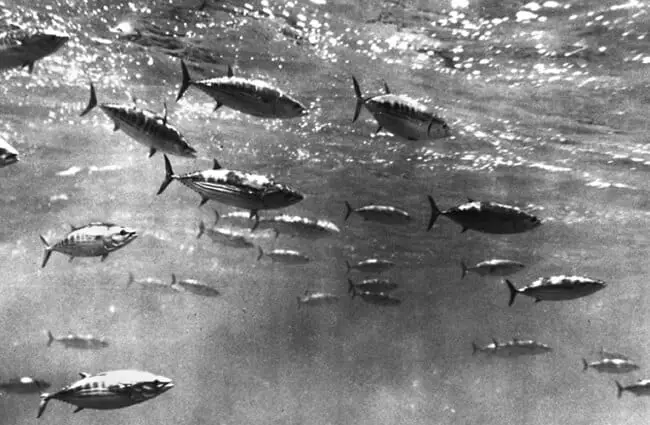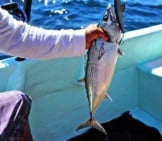The Skipjack is a species of tuna, also known as the Arctic bonito, aku, striped tuna, mushmouth (no, we didn’t make that one up), and more. You can find this species in tropical and into temperate oceans worldwide. It is one of the most popular commercial fisheries in the world. Read on to learn about the Skipjack.
Description of the Skipjack
This fish has a torpedo-shaped body with a thin tail fin. Its upper side is dark grayish blue, and its underside is light and silvery colored. On the lighter color of its underside, this species also has several dark stripes along its flanks.
Most adults measure about 3 ft. long and weigh around 15 – 20 lbs. However, exceptionally large adults reach lengths up to 3.5 ft. long and weigh up to 75 lbs.
Interesting Facts About the Skipjack
This species is one of the most important commercial fish species in the world. Learn what makes them so unique, below.
- Fecundity – One of the reasons this species makes such a good commercial fishery is its fecundity. It has a high fecundity rate, which means that it reproduces in large numbers and matures quickly.
- Breeding Size – Unlike some other animals, which reach sexual maturity at a specific age, this fish can breed once it reaches a specific length. They reproduce when they reach lengths of about 18 in. or so.
- Multiple Consumption – The Skipjack fishery markets this species as fresh, smoked, canned, dried, and salted.
- Safety Concerns – Researchers give two primary concerns when eating this species of fish, mercury and TBT contamination. Scientists consider this fish as a “moderate” risk for mercury contamination. Some stocks also test positive to tributyltin (TBT), which is a toxin from the paint on ships.
Habitat of the Skipjack
These fish live primarily in pelagic zones, or the open ocean. They generally do not swim any deeper than the epipelagic zone, or the areas where light penetrates through the water. Some also range into coastal regions. They also prefer waters that are warm and tropical, and only range into some temperate regions.
Distribution of the Skipjack
You can find this fish in tropical oceans worldwide. They also range into some temperate regions as well. This species lives in the Atlantic Ocean, Pacific Ocean, and Indian Ocean.
Diet of the Skipjack
This fish is carnivorous, which means that it eats other animals. They primarily eat krill and other zooplankton, but they also feed on fish, shrimp, squid, and more. For the most part, this species is opportunistic and eats just about anything that it can easily catch.
Skipjack and Human Interaction
Humans rely on this species quite heavily as a food source. In fact, it is one of the most prolific fisheries in the entire world. Over half of all commercial tuna catches are Skipjacks. This increased fishing pressure could potentially cause a population decline or collapse, particularly with unsustainable fishing practices.
However, the IUCN currently lists this species as Least Concern.
Domestication
Humans have not domesticated this fish in any way.
Does the Skipjack Make a Good Pet
No, you could not own this tuna as a pet. It is an open ocean fish that needs lots of space to swim. You simply couldn’t keep it in a home aquarium.
Skipjack Care
A variety of tuna species live in aquariums worldwide, including this fish. Aquariums house this tuna in massive tanks alongside other oceanic species. They feed them krill, shrimp, fish, and squid. The animals are important ambassadors for their species, teaching guests about the importance of sustainable fishing.
Behavior of the Skipjack
These fish live in large groups known as “schools.” The schools of tuna frequently school with other tuna species, and even sharks and whales.
Schools search for food together, and migrate periodically. This species also shows a preference for grouping, or shoaling, underneath floating objects. Unfortunately, that makes them an easy target for commercial fisheries to catch.
Reproduction of the Skipjack
Most populations breed year-round, with the exception of animals in colder temperatures. Researchers believe that in warm regions they breed about four times per year. Larger females produce greater numbers of eggs. It takes about a year and a half for the larval fish to reach 18 in. in length and sexual maturity.









![Red Angus Closeup of a beautiful Red Angus cowPhoto by: U.S. Department of Agriculture [pubic domain]https://creativecommons.org/licenses/by/2.0/](https://animals.net/wp-content/uploads/2020/03/Red-Angus-4-238x178.jpg)












![Red Angus Closeup of a beautiful Red Angus cowPhoto by: U.S. Department of Agriculture [pubic domain]https://creativecommons.org/licenses/by/2.0/](https://animals.net/wp-content/uploads/2020/03/Red-Angus-4-100x75.jpg)

